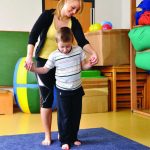Dog Therapy in Autism
- Individuals with ASD often suffer from difficulty in focusing, responding to sensory stimuli, and communicating with others, all of which have been shown to improve after the use of pet therapy
- A well-trained family pet can be a wonderful calming influence and ability to promote social interaction in individuals with autism and ASD. An affectionate dog provides unconditional love and friendship on a daily basis.
- Introducing a dog to children with ASD can result in a reduction of stress, anxiety, and irritation and can also promote a more relaxed environment for these children.
- Walking the dog provides both exercise and social bonding to ease conversation with other children. Learning to care for the dog teaches responsibility and practical skills.
- The goal is to create a very special connection between your child and the dog. When this happens, it can create wonders.
- Pets provide parents with opportunities to teach and ideal caring behaviors and consideration of a friend’s needs – both important social skills.
- A trained dog for the autism affected can accompany a child to decrease anxiety during medical or dental visits, school activities, shopping, and travel.
- These dogs have the ability to recognize and gently interrupt self-harming behaviors or help de-escalate an emotional meltdown in children with ASD.
- Such dogs can respond to signs of anxiety or agitation with calming activities such as leaning against the child (or adult) or gently
- Research has shown that such children tend to prefer pictures of animals to those of humans and are less responsive to the sound of the human voice as opposed to other stimuli.
- Golden retrievers, Labradors and Labra-doodles (lab-poodle mixes) are recommended as these breeds tend to have a calm temperament and high intelligence.
Dog Therapy – Dogs can provide companionship and support for children and adolescents with Autism Spectrum Disorders. When used as part of your child’s therapy, such Dogs can:
- Provide enhanced safety for the child;
- Teach the child responsibility in a passive manner
- Help control the child by commanding the dog
- Reduces elements of aggression and frustration which can lead to positive behavioral changes
- Comfort the child when upset
- It enhances the degree of predictability to social settings for both the child and parents
- Minimizes social stress levels, allowing greater participation in education and awareness, as well as social and leisure activities.



